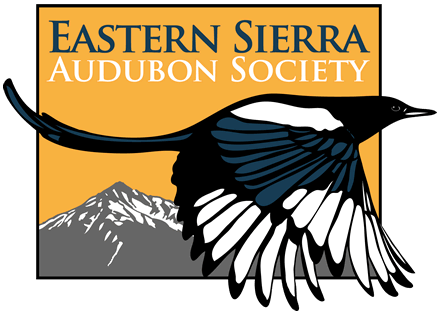[Originally appeared in the Sierra Wave newsletter, Vol. 28, No. 2, Nov-Dec 2009 – click here for original with photos]
With the approach of fall and winter in the Eastern Sierra, we bid farewell to species that arrived six months ago and won’t be seen for another six months. Virtually all flycatchers, vireos, swallows, warblers, and buntings move south towards milder temperatures and where insect food remains available all year. While a significant portion of the avifauna leaves, it is replaced by a suite of late fall migrants and winter visitors that spent the summer to the north of our area, some as far north as the Arctic.
Winter is the most unpredictable season, not just measured by how much or how little snow has fallen, but by how many of which bird species have occurred. Some species can be common one year and absent the next. The only predictability is that there will always be a few gems that delight the observers.
There is a long list of ducks that winter in the area but the highlights to look for are Eurasian Wigeon, Greater Scaup, Long-tailed Duck, Barrow’s Goldeneye, Hooded Merganser, and all three species of scoters. Tundra Swans regularly return in early November but observers are encouraged to scrutinize all swans closely so that the very similar Trumpeter Swan doesn’t visit without leaving a record! Three loons can occur in one year with Common Loon a regular visitor in fall, Pacific Loon is seen a couple of times each year, and every few years a Red-throated Loon is documented. Not yet recorded is the Yellow-billed Loon, which has been found several times in nearby Nevada and is a definite possibility in the Eastern Sierra.
Raptor species are few in number but their bearing and style captures birders’ attention. Bald Eagles typically appear in early November and while Ferruginous Hawks have become more regular than in the past Rough-legged Hawks have become more scarce. Winter is an exciting time for gull-lovers with a few reports of Thayer’s Western, and Glaucous-winged Gulls and one report each of Lesser Black-backed and Glaucous Gulls. All Loggerhead Shrikes should be given full attention so that a Northern Shrike doesn’t evade ‘capture.’
The little-brown-jobs, LBJs, can provide excitement as well. American Tree Sparrows and Harris’s Sparrows are probably here every year. Flocks of Oregon Juncos may be hiding Slate-colored, Pink-sided and Gray-headed Juncos and if one is really lucky, the 2nd Inyo County record of a White-winged Junco may be found. Lapland and Chestnut-collared Longspurs are in alfalfa fields, golf courses, lake margins, and barren ground. McCown’s and Smith’s Longspurs are extremely rare but have occurred. Red Crossbills and Evening Grosbeaks occasionally appear in good numbers… or not at all!
Some years many montane species descend to lower elevations and these invasions and their extent add to ornithological knowledge as well as provide birders with memorable experiences. Now is the time to review the birds mentioned so that when they cross your path you’ll be ready! Remember that many of these species are rare and require far more than raising your hand and saying, “I had a Warbling Widget!” to be considered a record in the ornithological history of the Eastern Sierra. Be ready to document your sighting with a photograph, a picture really is worth a thousand words, corroboration by other observers, or be willing to write a detailed description. It is a myth that this is a painful exercise!
Tags: duck, flycatcher, grosbeak, gulls, hawk, junco, longspur, loon, owl, sparrow, swan, vireo, warbler
